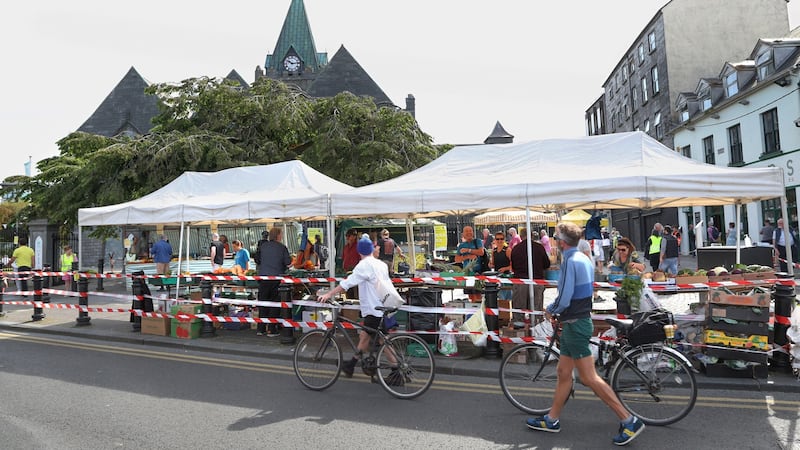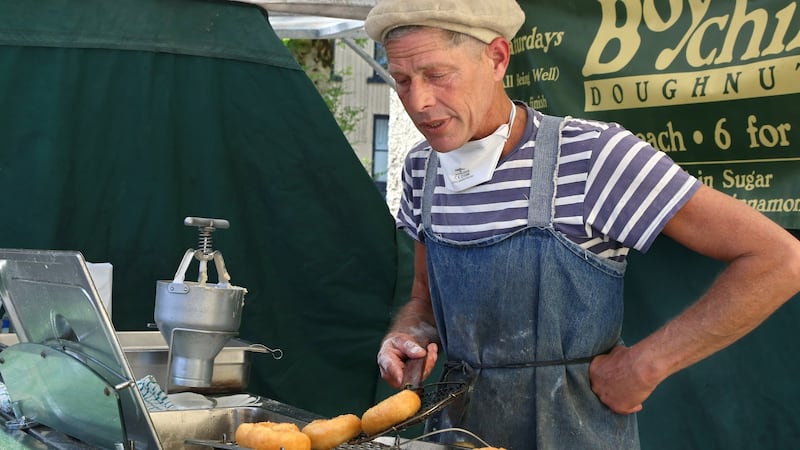For the first Saturday in decades, you can see from the top of the Galway Market to the end of it. The narrow thoroughfare which runs the length of Churchyard Street adjacent to St Nicholas’s and up Market Street becomes a big part of the sight, sound and taste of the Galway city weekend experience.
It has been here for centuries but in the earlier years there was probably a lot more buttermilk for sale and not so much sushi or madras curries. And for the past 20 years, it operated under a kind of organised bedlam. The market was so busy that you couldn’t see what the produce was until you inched your way along the thoroughfare using scent as well as sight.
Queues were long and haphazard. The mood was upbeat and sometimes manic. Visitors came out the other side bearing bags of organic vegetables, cheeses, oils, crafts, crepes, fish and handmade jewellery. Then, Covid-19 came.


“I am an artist so I went back to the drawing board there,” says Michael Brown.
“A lot of people went back to the garden and started growing their own produce. People have been doing a lot at home. Everything at the moment is under threat and we don’t even know where that threat is coming from at the moment. So we are just trying to set up a market where people can sell their produce.”
Brown’s stall has eggs and honey on this sunny morning but for the past 17 years he has established himself as an oyster trader. That business is literally on ice for now.
“Normally I would talk people through oysters and having oysters and going through the whole thing about the bays and where they are found but it takes too much time for the moment until we move through the phases.”
Social distancing dictates that the market is greatly reduced. It has food stalls only and they are set up on one side of the lane rather than both. The vendors, under the direction of the city council, have set up a one-way system. There are no tourists. Shop Street is all but deserted. The Garda has closed the Spanish Arch.
“At the moment this is fine for us but not for all the traders,” says Jeannette Cochen, who has had a vegetable stall at the market since 1985.
“It is only food stalls. And we have to find a way that all the traders can come back. If we move from here to another location, it means maybe that we never come back here. Nobody wants to take that risk. That is my personal opinion.”
Doughnut corner
It has been over 20 years since Danny Rosen made the natural career switch from sailor to doughnut maker. The New Yorker’s Boychik Doughnut stand has become one of the familiar features of the market. He has moved it from his usual spot to a newly created space across the road in the primary school yard.
“There is a patch of grass beside me. I took a pitch far from everybody and I think it is ideal. I am overjoyed. It is a compromise. I don’t wish it to be permanent but it is a very sweet little corner.”
When the market closed, he kept making doughnuts and, with his friend Lisa Regan, delivered them around the city to frontline staff in hospitals and the fire brigade and even the post office. Once, Lisa knocked on the wrong door and the family inside were so overjoyed to find a stranger trying to give them bags of doughnuts that she couldn’t disappoint them.
“So from then on we worked in that on every delivery. She would also knock on random doors and gift people donuts,” he laughs.
For now, he’s just delighted to be back, mixing batter and dishing up the goodies.
“Look it, we are going to have to accommodate the fact that the market is not going to be the same way for a while,” says Rosen, as he serves The Irish Times.
“This might be utterly optimistic of me but the market used to be a very family oriented kind of place and a very social place – like in the pub where you would get a random hook-up. Aw, I haven’t seen you in ages, that kind of buzz.
“You don’t get as much of that any more because local people stopped using the market in a big way because it is so jammed with tourists. And I am hopeful now that people will start coming to see the market as a real local market, and a more substantial, real experience too. That is how we are really serving the community, not just by serving tourists or Airbnb guests.
“You want cinnamon or cocoa on these?”










